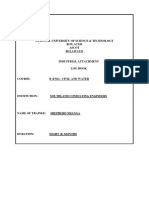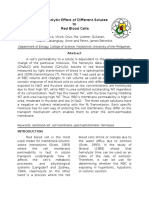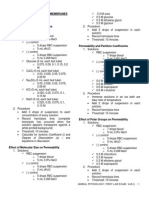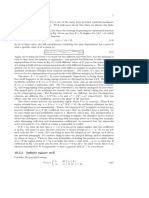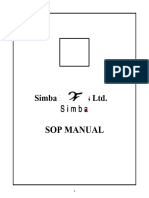Lab 1
Lab 1
Uploaded by
joenicaCopyright:
Available Formats
Lab 1
Lab 1
Uploaded by
joenicaOriginal Description:
Copyright
Available Formats
Share this document
Did you find this document useful?
Is this content inappropriate?
Copyright:
Available Formats
Lab 1
Lab 1
Uploaded by
joenicaCopyright:
Available Formats
LAB 1 : OSMOTIC FRAGILITY
OBJECTIVES: To determine the fragility of the erythrocyte membrane against the haemolytic effect of NaCl solutions of varying concentrations
INTRODUCTION: Osmosis is the diffusion of a solvent through a semipermeable membrane from a region of low solute concentration to a region of high solute concentration. The semipermeable membrane is permeable to the solvent, but not to the solute, resulting in a chemical potential difference across the membrane which drives the diffusion. That is, the solvent flows from the side of the membrane where the solution is weakest to the side where it is strongest, until the solution on both sides of the membrane is the same strength (that is, until the chemical potential is equal on both sides). Red blood cells are bound by a membrane which allows water to pass through while generally restricting the solutes. This process, called osmosis, causes cells to shrink due to loss of water when placed in hypertonic solutions. On the other hand, red cells absorb water (called endosmosis) when in a hypotonic medium. This results in swelling and ultimately haemolysis as the cell bursts. The osmotic fragility test uses this fact to determine the concentration of solute inside the cell by subjecting it to the haemolytic effects of solutions of different concentrations.
MATERIALS: 11 test tubes, NaCl (0.85%, 0.75%, 0.65%, 0.55%, 0.50%, 0.40%, 0.35%, 0.20%, 0.10% and 0%), Distilled water, Blood, Pipette, Spectrophotometer and cuvettes and Centrifuge, PROCEDURE: 1. 11 test tubes prepared and labeled as follows: 0.85%, 0.75%, 0.65%, 0.55%, 0.50%, 0.40%, 0.35%, 0.20%, 0.10% and 0% NaCl. 2. 5 ml of NaCl pipetted in each test tube according to the label and 5 ml distilled water pipetted in test tube labeled 0% NaCl. 3. 10 L blood (with added heparin or sitrat which act as anti coagulant) was pipetted at each test tube. The content of the test tube mixed carefully and the test tube sentenced to resting period of 20 minute at room temperature. 4. Test tubes shaked carefully and centrifuged for 9 minute at the velocity of 2000 rpm. 5. Supernatant transferred to labeled cuvettes. 6. Using supernatant from the test tube which is labeled 0.85% NaCl as reference (0% haemolysis) OD of each supernatant calculated using spectrophotometer with the wavelength of 540nm. 7. Percentage of haemolyis calculated using the following formula: OD Sample X 100% OD of the sample with 100% lysis 8. OD recorded and percentage of NaCl converted to mole/L and mOsm/L. 9. A graph percentage of haemolysis vs. concentration of NaCl plotted. (This graph is known as osmotic fragility curve).
QUESTIONS 1. A test tube with blood in it has a particular solution added to it. After several minutes, the solution is not clear anymore, but becomes red. Which solution was added to the blood to obtain this result? (a) 0.9 % saline (b) 5 % saline (c) Distilled water
2. A 0.8% saline solution would be _____ to the cytosol of a cell (a) hypotonic (b) hypertonic (c) isotonic 3. If you placed a peeled apple or potato in a 5 % salt solution, it would: (a) gain weight (b) lose weight (c) stay the same weight
You might also like
- Attachment Log BookDocument30 pagesAttachment Log BookShepherd Nhanga93% (15)
- SDS PAGE - Experiment and Report PDFDocument16 pagesSDS PAGE - Experiment and Report PDFHazar Hiary100% (1)
- Osmotic Fragility of Red Blood CellsDocument3 pagesOsmotic Fragility of Red Blood Cellschaudhry umar farooqNo ratings yet
- Cell Membrane Lab Report AssignmentDocument10 pagesCell Membrane Lab Report Assignmentlawrence mulenga100% (3)
- Osmosis in Red Onion Cells PDFDocument6 pagesOsmosis in Red Onion Cells PDFAnnieNo ratings yet
- NePA WalkThroughDocument8 pagesNePA WalkThroughvphuc1984100% (1)
- Erythrocyte Fragility TestDocument2 pagesErythrocyte Fragility Testkiedd_04100% (4)
- Osmotic FragilityDocument4 pagesOsmotic Fragilityk30119367% (3)
- Hema II Chapter 3 - OFTDocument19 pagesHema II Chapter 3 - OFTEsmael Adem MohNo ratings yet
- Animal Physiology LabDocument13 pagesAnimal Physiology LabAbi Nirmalan0% (1)
- Labreport 2Document9 pagesLabreport 2Anne MasangkayNo ratings yet
- PermlDocument11 pagesPermlFayeNo ratings yet
- First Lab Exam ReviewerDocument13 pagesFirst Lab Exam ReviewerBea Constantino100% (1)
- Osmotic FragilityDocument12 pagesOsmotic FragilityNithyah Paramasivam33% (3)
- Lab 5Document15 pagesLab 5Suhada IdayuNo ratings yet
- Osmotic FragilityDocument17 pagesOsmotic FragilitydenisaNo ratings yet
- B2 - Red Cell OsmosisDocument4 pagesB2 - Red Cell OsmosisirenetiangNo ratings yet
- Lab 3 TransportDocument5 pagesLab 3 TransportMark GirasolNo ratings yet
- Physiology Post Lab Data Sheet and AnswersDocument2 pagesPhysiology Post Lab Data Sheet and AnswerssirnNo ratings yet
- Hema 2 Lab 1Document31 pagesHema 2 Lab 1Jacque IterantaNo ratings yet
- Activity 5. TonicityDocument4 pagesActivity 5. TonicityBrian James BurtonNo ratings yet
- IsotonisDocument27 pagesIsotonisIllhaa AlvielhaaNo ratings yet
- OsmosisDocument14 pagesOsmosisSuhada IdayuNo ratings yet
- BIO1 OsmosisDocument2 pagesBIO1 OsmosisA.R.C.0% (1)
- Suspensions, Colloids and SolutionsDocument2 pagesSuspensions, Colloids and SolutionsJim Goetz88% (8)
- Osmosis PracticalDocument5 pagesOsmosis PracticalDebajyoti ChaudhuriNo ratings yet
- Laboratory ActivityDocument6 pagesLaboratory ActivityPutri RizkiaNo ratings yet
- Bio 101 Lab Report Prac 6Document5 pagesBio 101 Lab Report Prac 6bogosirenatoNo ratings yet
- Osmotic FragilityDocument22 pagesOsmotic Fragilityfatma522No ratings yet
- Bio 2Document6 pagesBio 2Hatice Sena YenigünNo ratings yet
- The Movement of Fluid Across The Plasma MembraneDocument33 pagesThe Movement of Fluid Across The Plasma MembraneZoya MoraniNo ratings yet
- Lab 1Document21 pagesLab 1فاطمة عدنان حسينNo ratings yet
- 2 PassivetransportDocument8 pages2 PassivetransportFayeNo ratings yet
- E1 Zoo120Document8 pagesE1 Zoo120Rafael VillanuevaNo ratings yet
- Zoo 120.1 - Experiment 3Document4 pagesZoo 120.1 - Experiment 3Rey Malvin SG PallominaNo ratings yet
- Practical Biochemistry (STBP2012) : Experiment 3: Purification & Characterization Of α -Lactalbumin, A Milk ProteinDocument20 pagesPractical Biochemistry (STBP2012) : Experiment 3: Purification & Characterization Of α -Lactalbumin, A Milk ProteinfaizzudDENT100% (2)
- Hematology and Blood TransfusionDocument73 pagesHematology and Blood Transfusionwycliffe kiprotichNo ratings yet
- TATIANADocument8 pagesTATIANAKaizer NdoloNo ratings yet
- Onion Cell - LAB 5 REPORTDocument8 pagesOnion Cell - LAB 5 REPORTedaviddavis9No ratings yet
- InmunologiaDocument12 pagesInmunologiaclaudia martinezNo ratings yet
- Background Osmosis Prac PDFDocument3 pagesBackground Osmosis Prac PDFOliver YehNo ratings yet
- Crop Physiology Exercise-5Document3 pagesCrop Physiology Exercise-5Ravikant MishraNo ratings yet
- Haemolysing Agents & Detection of Blood: Experiment 3Document18 pagesHaemolysing Agents & Detection of Blood: Experiment 3Naimah RashidNo ratings yet
- Experiment No. 2 Osmosis and Donnan Equilibrium 1Document1 pageExperiment No. 2 Osmosis and Donnan Equilibrium 1Raven GoseNo ratings yet
- HPLC: High Pressure Liquid ChromatographyDocument18 pagesHPLC: High Pressure Liquid ChromatographySyakirohFitriyati100% (1)
- Background - OsmosisDocument3 pagesBackground - OsmosisGalex YeveNo ratings yet
- Osmosis in Red Blood Cell: Click To Edit Master Subtitle StyleDocument14 pagesOsmosis in Red Blood Cell: Click To Edit Master Subtitle StyleTaggart SiaoNo ratings yet
- Transportation Across Plasma Membrane Lab ReportDocument13 pagesTransportation Across Plasma Membrane Lab Reportamansempoi33% (3)
- Lab Report 1 Final PDFDocument5 pagesLab Report 1 Final PDFJosh OronceNo ratings yet
- CC1 Lec PrelimsDocument36 pagesCC1 Lec PrelimsPatricia JoisNo ratings yet
- Lab Report 3Document5 pagesLab Report 3Dunya FANo ratings yet
- Proteins and Amino Acids PreDocument6 pagesProteins and Amino Acids PreKarina KhanNo ratings yet
- BIO 273 Week 5 Centrifugation and Red Blood CellsDocument10 pagesBIO 273 Week 5 Centrifugation and Red Blood CellsNipun SharmaNo ratings yet
- 9 Fluid Management During CraniotomyDocument39 pages9 Fluid Management During CraniotomyRafael MenesesNo ratings yet
- Osmosis: XCCC C CC CC CC CC CCCCDocument9 pagesOsmosis: XCCC C CC CC CC CC CCCCIwizpv DzimmieNo ratings yet
- Quiz 2Document11 pagesQuiz 2Ericka GenoveNo ratings yet
- Hematology NotesdocxDocument11 pagesHematology NotesdocxdmclmllNo ratings yet
- Ion Exchange ChromatographyDocument4 pagesIon Exchange Chromatographyviper121No ratings yet
- Hypovolemic Shock.: Critical Care Clinics May 1993Document22 pagesHypovolemic Shock.: Critical Care Clinics May 1993Anastasius HendrianNo ratings yet
- Osmosis in Red Blood Cell (2ndrevision)Document23 pagesOsmosis in Red Blood Cell (2ndrevision)aloydude1450% (2)
- Acid-Base and Electrolyte Handbook for Veterinary TechniciansFrom EverandAcid-Base and Electrolyte Handbook for Veterinary TechniciansAngela Randels-ThorpNo ratings yet
- Brochure EC200E StageV ENDocument24 pagesBrochure EC200E StageV ENHarisNo ratings yet
- MagneticMaterials1Document603 pagesMagneticMaterials1Adinda Van Den BergNo ratings yet
- Rapid Math Assessment Monitoring ToolDocument2 pagesRapid Math Assessment Monitoring ToolElmer HepeNo ratings yet
- Clinical Laboratory Automation A Case StudyDocument6 pagesClinical Laboratory Automation A Case StudyMekar PalupiNo ratings yet
- The Four Terrible Things That Are Destroying Boys in Our CultureDocument4 pagesThe Four Terrible Things That Are Destroying Boys in Our CultureСаша МироноваNo ratings yet
- PROFS DATABASEDocument35 pagesPROFS DATABASEadityabiswas2911No ratings yet
- A330 Instructor HandbookDocument202 pagesA330 Instructor HandbookPunthep Punnotok100% (2)
- 10.3.2 Infinite Square Well: −Iωt −Iet/¯ HDocument4 pages10.3.2 Infinite Square Well: −Iωt −Iet/¯ HChandler LovelandNo ratings yet
- Post, or Distribute: Data CleaningDocument30 pagesPost, or Distribute: Data CleaningAntonio FrianNo ratings yet
- The Vodka WarDocument3 pagesThe Vodka WarLaura TicoiuNo ratings yet
- Upstream Process Engineering Course: 4. SeparationDocument46 pagesUpstream Process Engineering Course: 4. SeparationReza SalimiNo ratings yet
- Quizo Yupanqui StoryDocument8 pagesQuizo Yupanqui StoryrickfrombrooklynNo ratings yet
- Lecture On X-Rays PDFDocument52 pagesLecture On X-Rays PDFArjun MaharajNo ratings yet
- Bedini SGDocument75 pagesBedini SGYorsh TorresNo ratings yet
- 12 1 2 Repository JTDocument244 pages12 1 2 Repository JTAndinetNo ratings yet
- DIP - Image Restoration PDFDocument29 pagesDIP - Image Restoration PDFEng. Dr. Dennis N MwighusaNo ratings yet
- Quality Manual - Simba Fashions Ltd.Document143 pagesQuality Manual - Simba Fashions Ltd.ABDULNo ratings yet
- CEY6496 GROUP PROJECT - Draft Report 10nnn NovDocument79 pagesCEY6496 GROUP PROJECT - Draft Report 10nnn NovabdullahNo ratings yet
- Pratt & Whitney Canada: Maintenance Manual MANUAL PART NO. 3034342Document18 pagesPratt & Whitney Canada: Maintenance Manual MANUAL PART NO. 3034342EstebanNo ratings yet
- Lesson Plan Reading 11Document10 pagesLesson Plan Reading 11Hoàng Trung ThànhNo ratings yet
- EC O-Day BookletDocument55 pagesEC O-Day Bookletshamroz khanNo ratings yet
- STREIF Formwork PDFDocument23 pagesSTREIF Formwork PDFformwork companyNo ratings yet
- FCG Company ProfileDocument9 pagesFCG Company ProfileAmr GawalyNo ratings yet
- Abalo, Cristelgen Educ 25 Module 1Document3 pagesAbalo, Cristelgen Educ 25 Module 1Cristelgen AbaloNo ratings yet
- GRADES 1 To 12 Daily Lesson Log Monday Tuesday Wednesday Thursday FridayDocument4 pagesGRADES 1 To 12 Daily Lesson Log Monday Tuesday Wednesday Thursday FridayKarmela VeluzNo ratings yet
- Made Easy Ce Set A 2019 PDFDocument75 pagesMade Easy Ce Set A 2019 PDFRaj Kumar AshishNo ratings yet
- Target Shots II-unlocked PDFDocument285 pagesTarget Shots II-unlocked PDFsaumya ranjan nayakNo ratings yet
- Allen StockDocument3 pagesAllen StockNeil GudiwallaNo ratings yet
